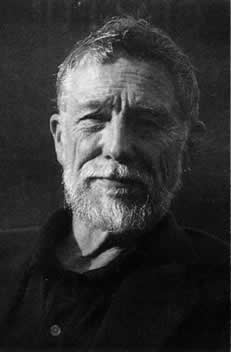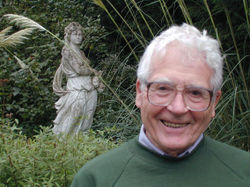 This past weekend the Ojai Poetry Festival featured the great American poet Gary Snyder, who read to a large crowd of listeners mostly from work written this century, especially his 2004 book of haibun called Danger on Peaks. (Haibun, we learned, is a mix of prose and haiku: Japanese professor Nobuyaki Yuasa has described it as having a relationship "like that between the moon and the earth: each makes the other more beautiful.”)
This past weekend the Ojai Poetry Festival featured the great American poet Gary Snyder, who read to a large crowd of listeners mostly from work written this century, especially his 2004 book of haibun called Danger on Peaks. (Haibun, we learned, is a mix of prose and haiku: Japanese professor Nobuyaki Yuasa has described it as having a relationship "like that between the moon and the earth: each makes the other more beautiful.”)
Snyder read poems linking the destruction of the Buddhas of Bamiyan in March 2001 by the Taliban to the destruction of the Twin Towers, among others, as well as an indelible new poem called "No Shadow." He concluded with his classic "For All," the conclusion to which was recited by all the poets and the crowd.
He then went away from poetry for one moment to warn of a recent trend toward nuclear energy.
"Some people who should know better," he said, mentioning Stewart Brand, were calling for the construction of new nuclear power plants to hold down carbon emissions. Snyder objected vociferously, arguing that climate change would not destroy life on earth, though it might make things difficult for humans for a few hundred years. He specifically went after famous British scientist James Lovelock, the man who first formulated the concept of Gaia, for saying nuclear waste is overly feared as a pollutant.
 To dramatize the point, in his recent book The Revenge of Gaia Lovelock has personally agreed to dispose of a nuclear power plant’s waste:
To dramatize the point, in his recent book The Revenge of Gaia Lovelock has personally agreed to dispose of a nuclear power plant’s waste:
I have offered in public to accept all of the high-level waste produced in a year from a nuclear power station for deposit on my small plot of land; it would occupy a space about a cubic metre in size and fit safely into a concrete pit, and I would use the heat from its decaying radioactive elements to heat my home. It would be a waste not to use it. More important, it would be no danger to me, my family, or the wildlife.
Snyder argued to the contrary that nuclear waste remains a serious threat, and further, that any move toward nuclear energy and the large-scale enrichment of uranium would surely increase the risk of the spread of nuclear weapons. He bluntly called Lovelock’s plea for more nukes "demented," and warned the crowd:
Keep your eyes peeled for trick arguments trying to lead us back to nuclear power.
Just this week on these pages, Joseph Romm brought up an argument against nuclear power I hadn’t heard before, that rising temperatures and diminishing supplies of water for cooling will make it more dangerous and less practical than in the past. Perhaps so. I am no expert, but Lovelock makes a strong case. For those interested in hearing more "trick arguments" from one of the leading scientists of our time, read on … and I for one will be interested to hear from those able to put them to rest.
- First and foremost, Lovelock makes an argument from risk, saying that if we allow CO2 to reach 500 ppm, temperatures will soar six to eight degrees, likely leading to the melting of Greenland and other ice sheets, drowning coastal cities around the world, forcing forests far northward, leading to major droughts and countless other disasters.
Carbon dioxide waste is invisible but so deadly that if its emissions go unchecked it will kill nearly everyone. The nuclear waste buried in pits and the production sites is no threat to Gaia and dangerous only to those foolish enough to expose themselves to its radiation.
- Lovelock claims that nuclear waste is less destructive than development.
One of the striking things about places heavily contaminated by radioactive nuclides is the richness of their wildlife. This is true of the land around Chernobyl, the bomb test sites of the Pacific, and areas near the United States’ Savannah River nuclear weapons plant of the Second World War. Wild plants and animals do not perceive radiation as dangerous, and any slight reduction it causes in their lifespans is far less a hazard than is the presence of people and their pets. It is easy to forget that we are now so numerous, almost anything extra we do in the way of farming, forest and home building is harmful to wildlife and Gaia.
- Lovelock adds that the acid rain caused by sulfur emissions is better than the alternative, even if it means haze and pollution.
… this haze is reflecting sunlight back to space and keeps those of us beneath it several degrees cooler than we might otherwise be. In some senses the acid rain is a partial cure for global warming. Just imagine how much worse the intense heat of summer in 2003 would have been without it, and how much worse it will be when this European [sulfur emission reducing] legislation starts to work.
Comments? Tell me something good …
 This past weekend the
This past weekend the 
